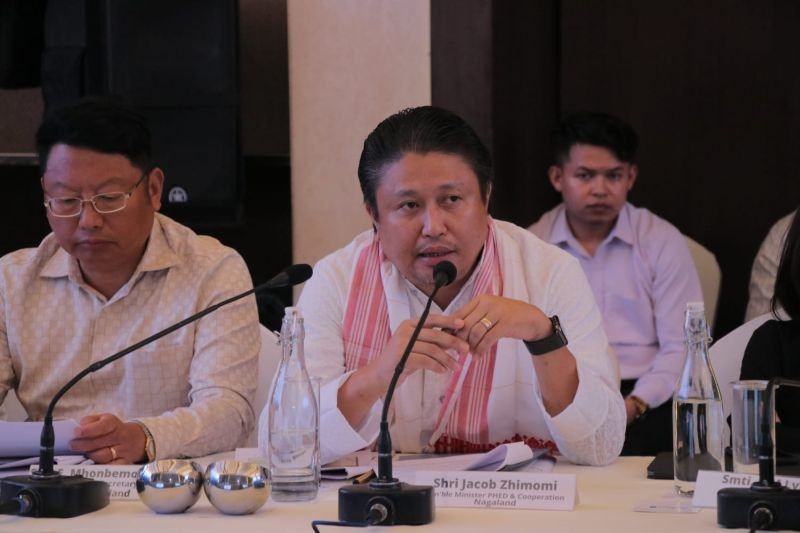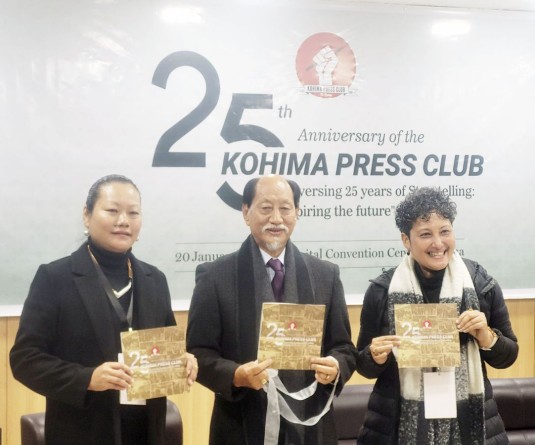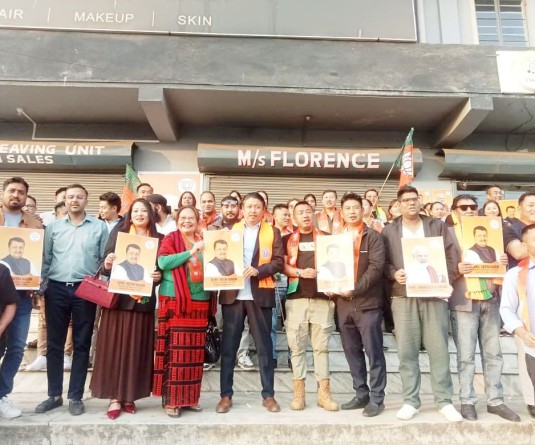Nagaland’s PHED minister Jacob Zhimomi at the review meeting of JJM, SBM (G) for NE states on July 6 at Guwahati.

Our Correspondent
Kohima | July 6
Nagaland attended the review meeting for implementation of Jal Jeevan Mission (JJM) & Swachh Bharat Mission (Grameen) for North Eastern states, held on July 6, at Guwahati.
Nagaland team was led by Public Health Engineering Department (PHED) Minister Jacob Zhimomi. Others includes; E Mhonbemo Patton, principal secretary to the Govt of Nagaland, PHED, Chief Engineer & HoD Repangyangba Longkumer and T. Sangtam, Chief Engineer Sanitation & WSSO, Nagaland.
The meeting was chaired by Gajendra Singh Shekhawat, Union Minister, Ministry of Jal Shakti.
Speaking at the meeting, Zhimomi assured that the state of Nagaland is fully committed to the successful completion of both the Mission JJM and SBM (G).
He appreciated union minister Shekhawat for organizing this review meeting with the ministers in charge of PHE/RWS Department of the North Eastern States to review the implementation of JJM and SBM(G).
“This will provide us an opportunity to share our experiences and strategies to complete the implementation of JJM and SBM (G),” he said.
2,65,928 households provided with FHTC in Nagaland
Zhimomi said that JJM in Nagaland was commenced in 2019-20. Nagaland took time to accelerate in the beginning. Now, the pace has been hastened, among others by shortening the project approval and award of work order procedure.
At present out of a total of 3,69,295 rural households in Nagaland, 2,65,928 households (72.01%) have been provided with Functional Household Tap Connection (FHTC).
The State has planned to saturate and provide water supply to the remaining 1,03,367 households by December 2023.
The state has certified 225 out of 472 Har Ghar Jal reported villages, which is 47.67 percent. Certification for the rest is also in the process, he said.
In Kiphire Aspirational/Mission Utkarsh district, out of a total of 14,991 households, the State has provided household tap connections to 12,842 (85.67 percent).
Out of a balance of 2,149, the 15 FC award portion, implemented by Rural Development Department (RDD) is 792.
We are co-ordinating with the RDD to ensure completion by December 2023, the minister said.
Coverage of Schools, Anganwadi centres and other Public Institutions are implemented under convergence by the Rural Development Department under the 15th Finance Commission grant.
Sustainability of drinking water sources
Ensuring sustainability of drinking water sources and water supply infrastructures created through JJM is a major concern for a hilly state like Nagaland, the minister said.
He described Jal Shakti Abhiyan - Catch the Rain 2023, with the theme “Sustainability of Drinking Water Sources” as “a very timely initiative of the Central Government, which will address issues of source sustainability though various converging plans.”
“However, considering the scale and complexities involved, a comprehensive plan for Springshed Management, preferably in Mission mode, may be initiated under the Ministry of Jal Shakti for long term solutions to address drinking water source sustainability,” he viewed.
He said that the coverage of Adhaar registration in the state is only 61.08 percent, which may ultimately affect the timely reporting of FHTC coverage in the state.
“We have noted the importance of monitoring and surveillance of the quality of drinking water and testing it regularly,” he told the review meeting.
He informed that 11 District Laboratories have been established across the state of Nagaland and one State Laboratory at Dimapur.
During 2023-24, water sample testing in laboratory was conducted as well as by using Field Testing Kit (FTK) numbering 12,127 tests in 1449 villages.
Remedial action has been taken for all the 112 samples found contaminated, the minister informed.
In 1472 villages, the department has trained 7,360 women for water quality surveillance through use of FTK.
Nagaland accords top priority for skill development
In accordance to JJM guidelines, the department have empanelled TPIAs (Third party implementing agency), in all the Districts, and payment is released only after verification and certification by the TPIAs. This has been done to ensure quality of the work implemented, the minister informed.
Stating that one of the reasons for the slow pace of implementation in the state was due to the shortfall/ lack of trained manpower, he said that the department have accorded top priority for Skill Development.
Till 2022-23, it had trained 2,691 personnel and targeting to train another 3096 personnel for multiskilled training.
Zhimomi expressed happiness that under SBM (G) Phase-II, construction of IHHL (Individual Household Latrine) are still being taken up and termed it as “very important particularly for a Tribal state like Nagaland, where new villages are formed from time to time.”
This year we have completed 1256 out of projected 4,322 IHHL, the rest will be done on priority, the minister said.
Stating that the State has till date declared 430 villages as ODF plus, out of 1425 villages, he said “We have reached this level from NIL at the start of the last Financial Year. We plan to cover 710 villages as per AIP during the current financial year, with the support of Rural Development Department.”
Grey Water Management
Considering the importance and utility of Grey Water Management, the minister said “this year we have kept a target of implementing Grey Water Management in 710 villages, out of which 32 are in progress. The rest will be taken up in phased manner.”
Stating that the state have now reached a stage where the investment in both JJM and SBM(G), will have to be handed over and owned by the Community, Zhimomi said “Therefore, we have started very intensive IEC and awareness campaign involving our ISA (Implementing Support Agency) like NEIDA/ Tata Trust.”
So far, 3 videos and several SBCC tools have been released in 6 local languages.
We will increase and accelerate the campaign and translate the IEC tools into more local dialects, he added.





